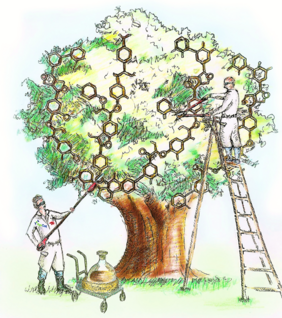The extensive exploitation of fossil resources as energy sources has led to severe ecological problems. Ongoing climate change has necessitated a shift to renewable and sustainable alternative feedstocks. In this context, the use of biomass to produce sustainable raw materials is a possible and promising path. Non-edible biomass in form of lignocellulosic biomass (LCB) is considered as one of the most promising renewable resources for the production of sustainable and biobased chemicals, polymers and biofuels. Biomass is converted into energy and useful chemicals in biorefineries, an important long-term goal of which is to replace petroleum as a feedstock for the chemical industry, thus creating the transition towards circular bioeconomy and green cities.
LCB is the total organic matter in the plant, which has been formed during plant growth via photosynthesis, by taking CO2 from the atmosphere and converting it with water and sunlight. Thus, LCB is a carbon-negative and fundamentally sustainable raw material which can be used in multiple biorefinery processes. Waste from forestry and agriculture and fast-growing perennial and switch grasses are currently the most common sources of LCB.
For its further processing in biorefineries, LCB has to be broken down into its main components: Cellulose and hemicellulose, which are polysaccharides and mainly consist of C5 and C6 sugars, and form 70-80% of LCB. And lignin, which is a chemically amorphous heteropolymer made by cross-linking of phenolic monomers, and forms 20-30% of LCB. These three components can be fragmented into smaller units (sugars and aromatics), followed by catalytic upgrading to fine chemicals with high atom economy and low environmental factor (E-factor).
In their current review, the UniSysCat researchers Majd Al-Naji, Francesco Brandi, Matthias Drieß and Frank Rosowski give an overwiev of the approaches for the processing of technical and native lignin. They report on different classical approaches for lignin valorization from LCB to valuable chemicals via thermal treatments, solvolytic valorization, acid or base-catalyzed process. These classical approaches are mainly aimed at valorizing of cellulosic fractions, while lignin and its products are considered secondary or by-products. Yet, the authors also explain the modern so-called „lignin-first“ approach to harness lignin’s wealth of aromatics. In this approach, native lignin from waste wood is extracted and fragmented into unstable monoaromatic units, followed by catalytic stabilization of the these unstable monoaromatics via reduction or oxidation to stabilized aromatic monomers (with a high yield of ~ 50%). These monoaromatics can be further upgraded via catalytic funneling to valuable phenolic compounds and olifens. In thier review, a special focus was led to the role of catalysts, process conditions and the type of utilized lignin. Finally, they outline the challenges involved in scaling up these modern promising technologies to pilot or industrial scale.
They conclude that for the transition towards a more sustainable biorefinery, all components of LCB must be efficiently valorized with minimal waste and CO2 emission. The modern lignin-first technologies using catalytic fractioning are promising approaches with high potential for industrial application. However, these technologies are still at the level of technology development and not yet ready for industrial use. Moreover, detailed life cycle assessment and techno-economic studies for these technologies on a large scale should be performed to judge their validity and flexibility. Because after all, the application of new technologies for the valorization of LCB only makes sense if the CO2 emissions are reduced compared to the existing petrorefineries.
The study has been published as an Open Access review article in Chemie Ingenieur Technik: M. Al-Naji, F. Brandi, M. Drieß, F. Rosowski, From Lignin to Chemicals: An Expedition from Classical to Modern Catalytic Valorization Technologies. Chemie Ingenieur Technik, 2022. https://doi.org/10.1002/cite.202200079
Beyond this review and within UniSysCat's vision of 2023-2025, a team of UniSysCat researchers involving Dr. Majd Al-Naji, Prof. Matthias Drieß, Prof. Reinhard Schömacker, Prof. Arne Thomas and Prof. Peter Neubauer is developing an approach to couple chemio-bio and electrocatalytic methods in flow systems for the selective valorization of lignocellulosic biomass to valuble chemicals. This approach aims to make lignocellulosic biorefienry more sustainable and energy efficient, with high atom economy and low E-factor.



